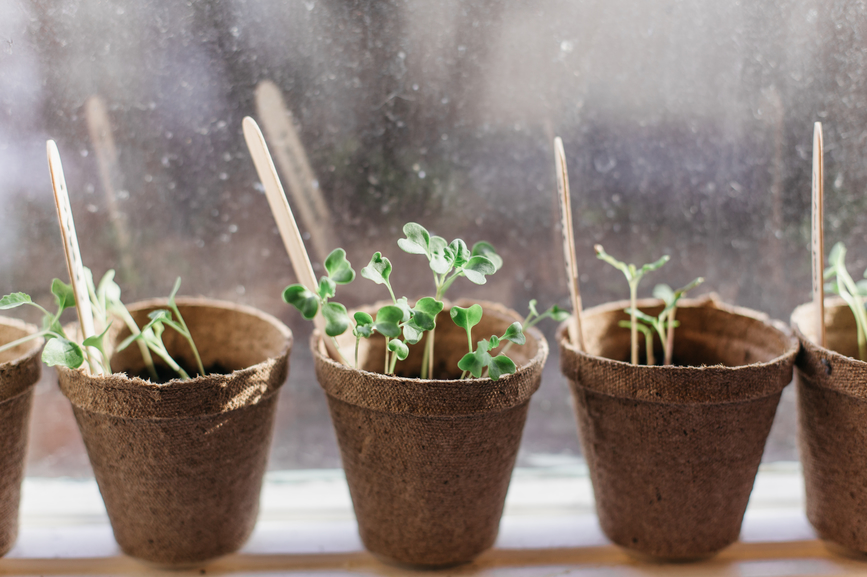Houseplants for Small Spaces

1. African Violets (Saintpaulia ionantha)
Named the National Garden Bureaus 2024 Houseplant of the Year, for very good reason. Universally popular, we love the African violet due to its petit appearance, constant blooming and ease of care. Furry heart-shaped leaves and bright flowers mean that any space can benefit from these delightful botanicals. Like many other houseplants, African Violets help purify the air from pollutants and toxins, improving your overall air quality. Plus, there is a variety for every aesthetic preference (hello ruffled leaves with variegated flowers) and they are non-toxic to both children and animals.
2. Spider Plants & Other Hanging Plants
When you’re running low on horizontal space, consider thinking vertically. For an easy integration of nature into your home, hang planters above window sills or in corners of rooms. Aesthetically pleasing and visually engaging, spider plants are often considered the easiest foray into working in small spaces in this way. Chlorophytum comosum showcases bursting variegated foliage, hanging miniature ‘babies’ (that can be offered for propagation to friends) and can survive long-periods without water. Moreover, these plants are considered therapeutic; they help reduce cortisol levels (hormones related to stress) and anxiety and tension. Other contenders for filling vertical areas include: English Ivy (Hedera helix), String of Beads (Senecio rowleyanus) and the ever-loved Philodendron species.
3. Living Stones (Lithops spp.)
Another excellent addition to our houseplants for small spaces are the ‘living stone’ succulents. Essentially like a curiosity, these are some of the most unique succulents you can grow and they’re tiny. With very little care, these low maintenance plants are here for the long ride if taken care of properly, 40-50 years in some cases. Besides being easy to keep, they symbolize endurance and patience and are a nod to sustainable living. The latter very much aligning with our core lifestyle values.
Enhancing Houseplants in Small Spaces

1.The Whimsical World of Terrariums
Taking the term small spaces quite literally, terrariums are incredible compositions of the natural world. Created in glass structures with endless variety, something can be found for every home and taste. From traditional Victorian style structures to modern orbs, even minute ones can be impactful focal points. Tap into your creativity by bringing together petite plants that quickly thrive in these environments; mini ecosystems that need very little care once established. Really, some will not require additional watering once set. We love to see Baby Tears (Soleirolia soleirolii), Polka Dotted Plants (Hypoestes phyllostachya), Aluminum plant (Pilea cadierei) and Creeping Fig (Ficus pumila).
Julie’s Notes*: A general rule of thumb is that closed terrariums are ideal for humidity loving plants. Open-terrariums are preferred for plants that do well in above-average humidity. If you’re drawn to cacti and succulent species, look to decorative bowls and vessels instead, as neither thrive in any kind of humidity.
2. Kokedama
In essence, kokedama, meaning ‘moss ball’ grows plants in a natural and controlled way… literally within a moss ball. It is a Japanese art form that is gaining popularity (even though it’s centuries old). Initially introduced so that the lower classes could practise a kind of bonsai. A visually intricate and rejuvenating plant feature that can either be hung or placed in a dish to enhance all small spaces. And the size? All dependant on the plant you choose to wrap.
Spend an intentional morning or afternoon creating your own. Begin by selecting a plant that doesn’t grow too quickly or get too large. Additionally, avoid cacti and succulents and opt for something that is comfortable in higher humidities. We recommend Pilea species, Dwarf ZZ plants (Zamioculcas zamiifolia ‘zenzi’), or Pothos species when making your first kokedama. Next, mix a suitable soil mix, (peat/clay are best) with some water and surround the root bulb of your plant, add moss and with twine secure around the ball. When watering, simply soak or mist for best results.
May your spaces, regardless how small, welcome and benefit from the introduction of nature and beautiful houseplants. For more reading and additional inspiration on all things home garden and lifestyle, explore The Wild Blog. Hoping to enhance your large spaces? Learn more in our next blog release. P.s., we’d love to connect, if you don’t already, be sure to follow us on Instagram and Pinterest!
*Julie is the founder and creative director here at Emerson Wild. She has years of experience working and collaborating with high-end residential and commercial clients that she shares with you through resources and soon experiences and quality products.




